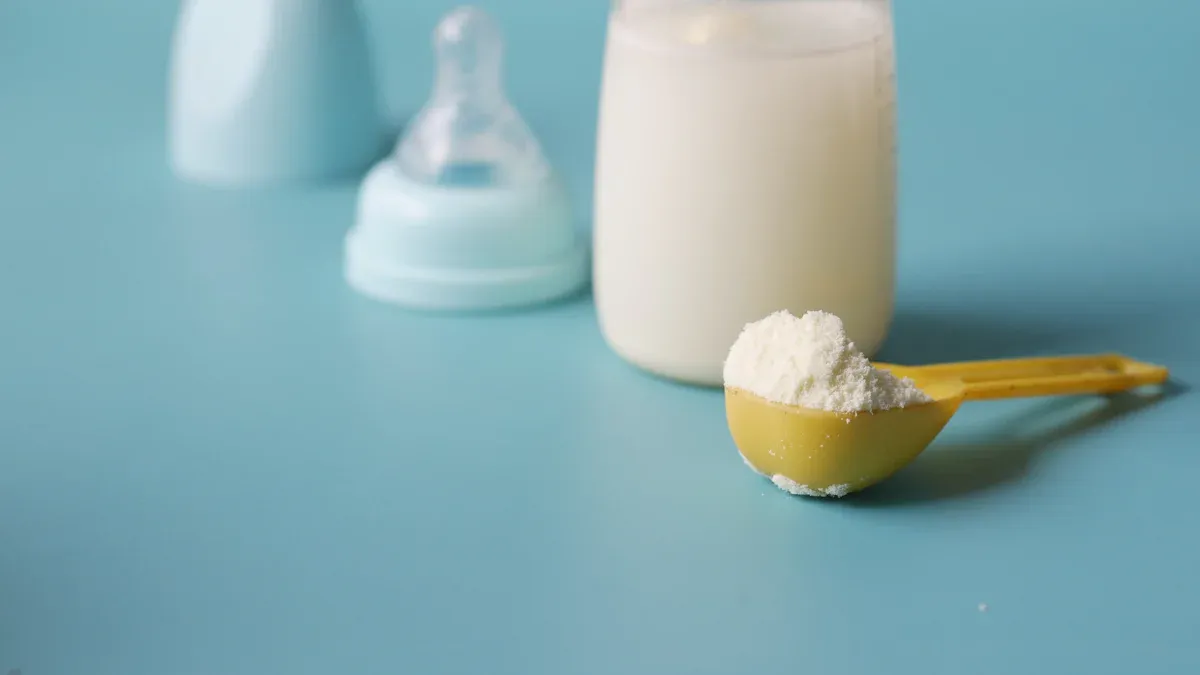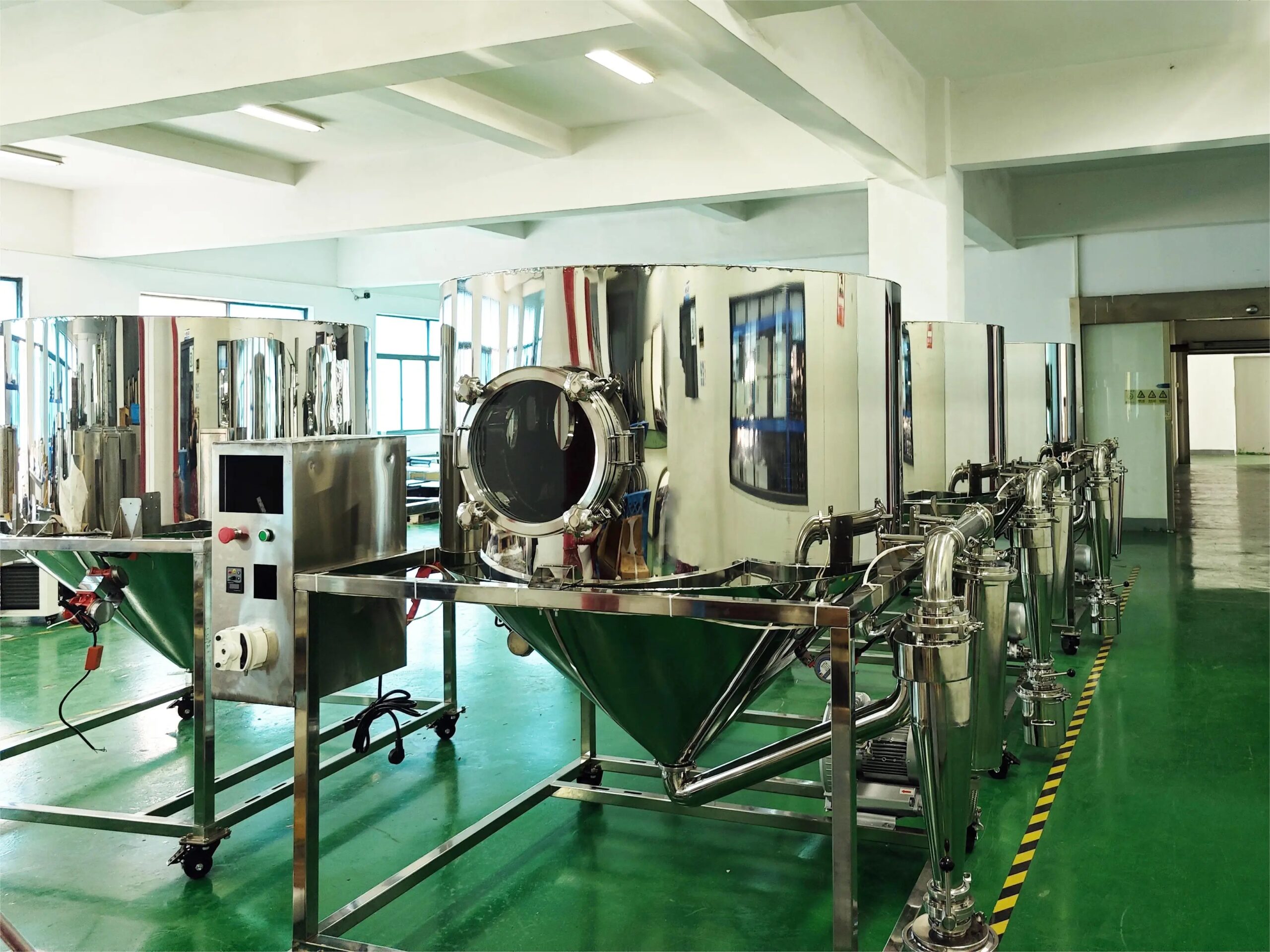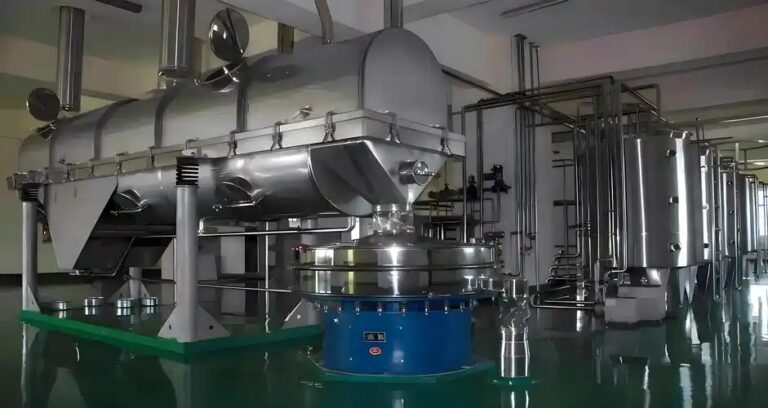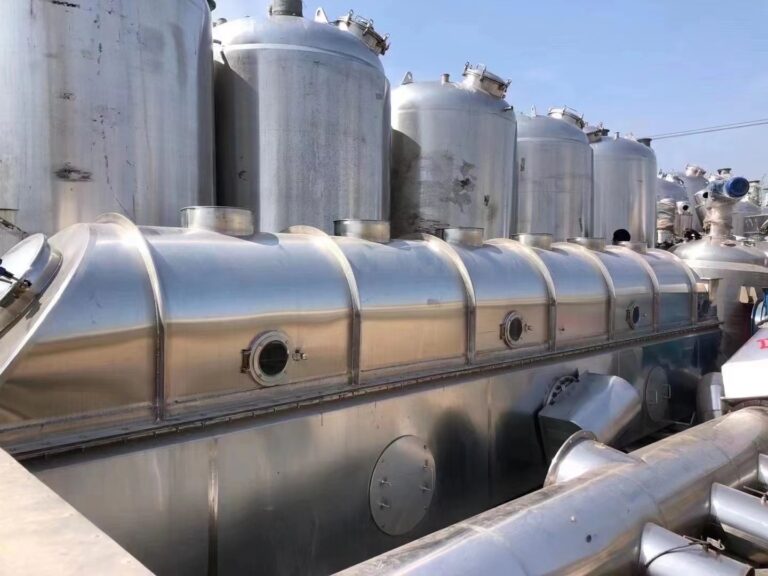Как работает машина для спрей для молока шаг за шагом
A milk spray dryer machine changes liquid milk into milk powder through a series of precise steps. The process begins when the machine breaks milk into tiny droplets. These droplets meet a stream of hot air, which quickly removes moisture. Dry milk powder forms and is collected for use. This method supports rising global demand for milk powder due to its long shelf life and convenience. Many producers use this technology to meet the needs of growing markets and changing lifestyles.
Ключевые выводы
A milk spray dryer machine turns liquid milk into powder by breaking it into tiny droplets and drying them quickly with hot air.
The process includes preparing milk, atomizing it, drying in a hot air chamber, collecting powder, and packaging to keep it fresh.
Spray drying preserves milk’s nutrients and flavor while extending shelf life and making storage and transport easier.
Controlling droplet size, drying temperature, and airflow helps produce high-quality powder and prevents problems like clumping.
Modern machines improve energy use and safety, supporting efficient, clean, and sustainable milk powder production.
Milk Spray Dryer Machine Basics

What It Does
A milk spray dryer machine transforms liquid milk into dry powder through a series of carefully controlled steps. The process begins with the preparation of liquid milk, which often involves filtration and preheating. This step ensures the milk flows smoothly and atomizes well. The machine then uses a nozzle or rotary atomizer to break the milk into a fine mist of tiny droplets.
The fine droplets increase the surface area, allowing for rapid drying.
Следующий, hot air—usually heated between 100°C and 300°C—enters the drying chamber. The hot air mixes with the droplets, causing moisture to evaporate within seconds. The dried milk particles fall to the bottom of the chamber or move to a cyclone separator, where the powder is collected. This process preserves the nutritional value and flavor of the milk while creating a consistent, высококачественный порошок.
Main operating steps include:
Preparing and filtering the liquid milk.
Atomizing the milk into fine droplets.
Rapidly drying the droplets with hot air.
Collecting the dry milk powder.
Why Use It
Dairy producers choose a milk spray dryer machine for several important reasons. The machine extends the shelf life of milk by removing most of the water, making storage and transport much easier. It also helps create a wide range of dairy products, such as whole milk powder, skim milk powder, and infant formula.
The spray drying process keeps the milk’s nutrients, вкус, and solubility intact.
The machine supports fast and efficient production, which saves time and energy.
The powder produced has good flow properties and dissolves easily in water.
Safety and quality standards play a key role in the operation of a milk spray dryer machine. International guidelines, such as those from the International Electrotechnical Commission and the International Dairy Federation, ensure that the machine runs safely and produces clean, высококачественный порошок. These standards help protect workers and consumers while supporting sustainable and efficient dairy processing.
Main Steps in Spray Drying

Приготовление корма
The first step in the milk spray drying process is feed preparation. Workers start by creating a uniform and pumpable milk solution. They filter the milk to remove impurities and sometimes concentrate it to reduce water content. This step ensures the milk flows smoothly through the system and atomizes well. Proper feed preparation helps the milk spray dryer machine work efficiently and produce high-quality powder.
Кончик: Removing impurities at this stage prevents blockages and improves the final powder’s quality.
Распыление
Распыление transforms the prepared milk into tiny droplets. The milk spray dryer machine uses either a rotary atomizer or a nozzle for this step. The feed liquid passes through the atomizer under pressure. The atomizer breaks the milk into fine droplets, increasing the surface area for drying. The size of these droplets affects the final powder’s moisture and particle size. Rotary atomizers create finer particles, while nozzles offer better control over размер капли.
The machine feeds concentrated milk into the atomizer.
The atomizer or nozzle turns the milk into a mist of fine droplets.
Droplet size determines how quickly and evenly the milk dries.
This process prepares the milk for rapid moisture removal in the next stage.
Сушильная камера
The drying chamber is where most of the water leaves the milk. Hot air enters the chamber at temperatures between 105°C and 280°C. The fine milk droplets meet this hot air, and moisture evaporates within seconds. The chamber removes about 87% of the water from the milk.
Air Temperature Type | Typical Temperature Range (°С) |
|---|---|
Температура воздуха на входе | 105 – 280 (commonly 130 – 200) |
Температура воздуха на выходе | 38 – 65 |
The airflow pattern inside the chamber affects drying efficiency. In a co-current system, hot air and milk droplets move in the same direction. In a counter-current system, they move in opposite directions. Uniform airflow helps dry the milk evenly and saves energy. Studies show that horizontal airflow patterns can reduce energy use and improve drying results. Instabilities or uneven airflow can cause poor drying and lower product quality.
Operators control the final moisture content by adjusting the exhaust temperature. Lower exhaust temperatures mean less moisture remains in the powder.
Коллекция порошков
После высыхания, the milk powder separates from the moist air. The powder falls to the bottom of the chamber or moves to a cyclone separator. Workers collect the powder in plastic-lined paper sacks or other containers. The collection method protects the powder from contamination and keeps it dry. Spray-dried milk powder usually has high solubility and good flow properties. These qualities make it easy to handle, package, and dissolve in water.
Примечание: Larger powder particles flow better and are easier to package.
Cooling and Packaging
The final steps are cooling and packaging. The powder leaves the drying chamber at a high temperature. Cooling prevents clumping and keeps the powder stable during storage. Workers often use fluid bed dryers to cool the powder and adjust its moisture content. After cooling, they package the powder in airtight bags or containers. Proper packaging protects the powder from moisture and air, preserving its quality and shelf life.
Feed preparation
Распыление
Drying in the chamber
Cooling and packaging
Each step in the milk spray dryer machine process plays a key role in turning liquid milk into a safe, высококачественный порошок.
Key Components of a Milk Spray Dryer Machine
Feed Pump
The feed pump moves liquid milk into the milk spray dryer machine. It controls how much milk enters the system at any time. By adjusting the pump speed, operators can change the flow rate. This control helps balance drying speed, использование энергии, and powder quality. A steady flow from the feed pump keeps the process smooth and prevents clogs. When the pump works well, the final milk powder has better solubility and even particle size.
Кончик: Regular checks on the feed pump help maintain consistent powder quality.
Atomizer
The atomizer turns the milk into a fine mist of droplets. These droplets usually range from 10 к 500 микрометры in size. The atomizer can use a spinning disc or a nozzle. The size and shape of the droplets depend on the atomizer’s speed and design. Smaller, uniform droplets dry faster and more evenly. Good atomization leads to milk powder with the right texture and easy mixing in water. If the atomizer gets clogged or worn out, the powder quality drops.
Сушильная камера
The сушильная камера is the main area where water leaves the milk droplets. Hot air flows through the chamber and mixes with the mist. The chamber uses special airflow patterns and temperature controls to dry the milk quickly and evenly. Features like adjustable shelves and airflow guides help spread heat and air. Sensors watch the temperature and humidity to keep drying conditions just right. These design choices protect the milk’s nutrients and make sure the powder does not burn or clump.
Cyclone Separator
The cyclone separator collects the dry milk powder from the air. As the air and powder spin inside, the heavier powder falls to the bottom. The clean air exits at the top. This step keeps the powder from escaping and reduces waste. The cyclone separator also helps keep the work area clean and safe. Efficient powder collection means less product loss and better hygiene.
Packaging System
The packaging system prepares the milk powder for storage and shipping. Common packaging includes metal cans and flexible pouches. These containers block moisture, воздух, and light, which keeps the powder fresh. Machines fill the packages with the right amount of powder and often use nitrogen gas or vacuum sealing. These methods remove oxygen and stop spoilage. Good packaging protects the powder’s taste, питание, and flow properties until it reaches the customer.
Benefits and Challenges
Преимущества
Milk spray dryer machines offer many benefits for dairy producers and consumers. These machines help create high-quality milk powder with consistent texture, вкус, and nutrition. Operators can control particle size and drying temperature, which preserves the milk’s nutrients and improves solubility.
Producers achieve longer shelf life by removing moisture, which prevents spoilage and stops microbial growth.
The powder form makes storage and transportation easier, reducing space and shipping costs.
Closed processing systems improve safety and hygiene, protecting both workers and the final product.
Efficient and scalable production lowers costs and supports large-scale operations.
The process uses energy wisely, especially with new features like heat recovery systems and ultrasonic-assisted drying, which can cut energy use by up to 35%.
Примечание: Spray drying balances energy efficiency and product quality better than most other drying methods. It uses less energy than freeze drying and keeps the powder’s taste and solubility.
Технология сушки | Operating Cost Comparison | Suitability & Примечания |
|---|---|---|
Распылительная сушка | Best for large-scale milk powder production | |
Заморозить сушку | Much higher | Premium quality, small scale |
Барабанная сушка | Lower capital cost | Good for high volume, less control |
Сушка в псевдоожиженном слое | Переменная | Multi-stage processing |
Микроволновая сушка | Varies | Depends on product |
Common Issues
Despite many advantages, milk spray dryer machines face some challenges. Powder sticking and caking can occur if the drying temperature gets too close to the powder’s glass transition temperature. Sticky powder can clog the system and lower product quality.
Sticky-point temperature affects when powder particles start to clump together.
High lactose content lowers the glass transition temperature, making sticking more likely.
Free fat on the powder surface increases the risk of caking and poor flow.
Changes in airflow or humidity inside the chamber can lead to uneven drying and wall deposits.
Operators can reduce sticking by adjusting protein levels, using additives like maltodextrin, and controlling airflow patterns.
Кончик: Regular monitoring and small adjustments in protein or carbohydrate content can help prevent sticking and improve powder flow.
Environmental impact is another concern. Spray drying uses a lot of energy, which increases the carbon footprint. Newer machines use heat recovery and water recycling to lower energy use and waste. Manufacturers also recycle materials like stainless steel to reduce environmental harm.
Innovations such as AI-driven controls, electrostatic powder collection, and modular designs continue to improve efficiency and sustainability in modern milk spray dryer machines.
A milk spray dryer machine transforms liquid milk into powder through several key steps. Each stage—feed preparation, atomization, сушка, powder collection, and packaging—plays a vital role in product quality. Understanding these steps allows producers to:
Control droplet size and drying temperature for consistent powder.
Adjust feed properties and residence time to prevent defects.
Optimize equipment and storage for better shelf life and safety.
This knowledge helps dairy producers troubleshoot issues and improve efficiency.
Часто задаваемые вопросы
How does a milk spray dryer machine keep milk powder safe from germs?
The machine uses high temperatures to remove water quickly. This heat kills most bacteria and germs. The closed system also keeps outside air and dust away from the milk powder.
What types of milk can go into a spray dryer?
Producers can use whole milk, skim milk, or even milk with added vitamins. The machine works best with filtered and concentrated milk. This helps create powder with good taste and nutrition.
Why does milk powder sometimes clump together?
Milk powder can clump if it absorbs moisture from the air. High fat or sugar content can also cause sticking. Proper packaging and storage help keep the powder dry and free-flowing.
How do operators control the final moisture in milk powder?
Operators adjust the exhaust temperature and airflow in the drying chamber. They use sensors to check moisture levels. Lower exhaust temperatures leave more moisture, while higher temperatures remove more water.
Can spray drying change the taste of milk?
Spray drying keeps most of the milk’s flavor. The quick drying process helps protect taste and nutrients. If the temperature gets too high, some flavor loss can happen, but modern machines control heat very well.
Кончик: Store milk powder in a cool, dry place to keep its taste and quality.




